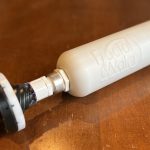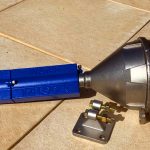Link to PDF
Journai of Magnetism and Magnetic Materials 83 (1990) 525-526 North-Holland
525
EXPOSURE OF IRRIGATION AND DRINKING WATER TO A MAGNETIC FIELD WITH CONTROLLED POWER AND DIRECTION
I.J. LIN and J. YOTV AT
Department of Mineral Engineering, Technion, Haifa 32000, Israel
Magnetic treatment affects the quality of irrigation and drinking water. It was shown that treated water cont ribu tes to increase in farm yields in both livestock and crop farwing, yield being expressed in quantity and quality of the produce and i n the specific economic contribu tion.
1. Introduction
The professional literature contains refs. [1-3] to the physical technology for the pre-treatment of water used for drinking and agricultural irrigation for the purpose of changing its physical characteristics, so as to increase the yield and crop of plant and livestock. This technol ogy is based on the application of an external magnetic field, mechanical or hydraulic energy.
These methods are not applied i n practice because of the low efficiency of the installations and the lack of scientific and engineering understanding of the mag netic action. These are the reasons why professional pu blications are received with much dou bt by academics and engineering specialists.
I n basic research work carried out at the Technion on the effect of low power magnetic fields on the characteristics of water in laminar flow, it was found that these magnetic fields affect the functioning of inorga nic membranes [4). An improvemen t in the ef ficiency of performance and the kinetics of the process was obtained. Based on these findings it was decided to examine t he t ransfer of mass through organic mem branes, and when positive preliminary indications were found, a field experi ment was planned for the t reat ment of water for crops and animals, in order to examine the cumulative effect in an agricultural trial.
The research project iasted four years and piaced em phasis on the four following aspects [5]:
a ) Type of apparatus: Strength of f ield, gradient. nat u re of magnetic circuit. direction of water flow. flow regime, etc.
01 Water quaii ty: Type of solutes, composition and quanti ty. electrical conductivi ty. pH, temperature.
c) Operating condi tions: Vol u me of flow. f u nctioni ng of open and closed circuit. pressure drop, t ype of installa tion. maintenance procedure.
d) C’osts and engineeri ng sui tabili ty for potential users. The field experiments included various livestock (ca t tle, goats. sheep). poult ry (hens, geese, turkeys) and prod uce
0304-8853/90/$03.50 El sevier Science Pu blishers B.V. ( Nort h-Holland)
( vegetables, f ruit, etc.) to determine the effectiveness of pre- treat ment, i ts strength and ou t pu t. dependi ng on the various parameters. Based on the findings, it was possible to optimize the engineering design, the system and its construction, and to improve the equipment. At present there are already more than 270 such u nits operating locally on farms.
- Field tests
-
- Dair y farm on Kibbut z Gvar
A wa ter pipe suppiying a group of milking cows was treated magnetically. A con trol group of cows received u ntrea ted water as usual. The two groups received the same feed and other conditions were identical. They were milked separately. The group on treated water yielded more milk, with the same percentage fat. Lacta tion peri od. non-productive days and veterinary condi tions were better. I mpregnation was bet ter.
-
- Calves on Kibbw:. Gvat
Week-old calves were selectivel y t ransferred to con trolled growth stables receiving magnetically t rea ted wa ler only. where they slayed till three mon1hs old. This group grew 12% faster than the control group. On the same farm. observations were made on the growth of male calves. Three-month old calves were transferred to con trolled growing pens where t hey dra nk magnet ically t rea ted water. They showed increased weight gains. Thei r mea t contained 30 to 40 less kg fat ac 10 to 1 2 rnontbs.
-
- Geese 011 farm H aroge1.•
Gosli ngs grow intensi vely from one-day to two months. Magnetic pre-t reat men c of t hei r wa ter resul ced i n i mproved performance: increased dai ly weight gai ns. generally i mproved health and a greater economic re-
526 I.I I.i n. ./. YotuJ/ / M ag11e11c rreatment of water in agricuflure
t u rn to the farmer. The magnetic wa ter system showed a drastic reduction of mineral coating in the pipes and i n water containers, clean drinking areas and an absence of blockages in the water cups that normall y cause noodi ng i n t he cages.
-
- Sheep farm at Ciimr 7.ayad
Sheep are culti va ted for milk. meat and wool. All three factors showed a considerable increase in yield: t here was a rise i n milk output af ter the flock was sheared in comparison wi th the usual ou tput.
2.5. Turkeys at N ahalal
Weight increases. Increase i n percentage of layers. longer laying period. longer peak laying period. im provement in fertility and percentages.
1.6. :\.f elon on Sourh Araua
An i ncrease i n yield. fruit size and sugar content was achieved [6].
A f urther series of trials is now in progress on goats, pigs, maize (corn ). cotton, orchards and ind ustrial tomatoes.
I t is possi ble to say definitel y that on most of the
experimental si tes. in various branches of agriculture. gains were achieved in yield and outpu t which resul ted i n i ncreased farm income varyi ng between 5% and 20%. The level of retu rn i n individual farm depends on three key factors: the type of equipment, the water quality
and the mode of operation. In most cases the following facts are clear:
- The effect of pre-treatment depends on the kind of water, its contents. temperature, equipment and i ts location, operational factors, such as water volume, speed of flow, installation. maintenance, etc.
- Conditions exist which completely prevent the phe nomenon. For example: upper limi t of liquid tem perat ure. u pper and lower barriers to solutes and the ki nd of solute. certain flow regimes, presence of other nea rby electromagnetic fields. relationshi p be tween magnetic field vectors and fluid speed. etc.
1 n t he curren t research work. ha si c research was ca r ried ou t alongside the experimen tal work . The dependence between the magneto-chemical and the magneto-h yd ro dynamic effects was shown, which contribu ted to a broad and f u ndamental u ndersta ndi ng of the su bject. As a rule. electro-cond uctive fluid (such as tap water ) flowing at modera te speed t hrough a magnetic f ield. creates direct electric curren ts and vol tages (which can be calculated and measured ). I f t he basic condi tions. k nown f rom t heory and princi ples of elect romagnetism
( magnetohyd rodynamics) exist, then t he req ui red cnergv for indica tive ef fect is obtained f rom the ki netic energy of the wa ter and not f rom the magnetic ci rcui t.
3. Conclusions
- Elect ro-magnetic treatment of wa ter resulted in a considerable contrib ution to the various branches of farming. The economics from t he cost/benefit aspect are proven. Substantial con tributions to other farm· ing activities (fish farming, algae. vegetables and f ruit. other livestock) can be expected.
- All experiments were carried out u nder f ield condi tions on a broad scale. I mportant parameters for the f ull functioning of the magnetic system were de termined.
- Electro-magnetic uni ts for wa ter trea tmen t are avai l able commerci ally.
d ) It appears tha t the i ntegra tion of water treatment as discussed above can lead to a break through of maxi mu m benefi t to agricul tural outpu ts.
e) The com mon features testif y to the existence of similar mechanisms and processes wi th regard to the f untion of water. common operative factors and sim i lar specif ic con tri butions.
References
[ I ] K. Syers. ‘-lz Farmer 4 (1983) 24.
[2] S. Gishi n. Gradi narska i Lozarska N a u ka 1 1 ( 1 974) 61
[3] P. Povlov a nd S. Ciyurov. Fiziologi ya na Rasteni yata lJ
(1983) 65.
{4] l..J. Li n and S. Nad1v. Magn. Sep. News 2 ( 1 988) 137.
[5] IJ. Lin and .I. Yotva t. Water !mg. Rev. 8 ( 1 988) 16. [6] U. Lin a nd .I. Yotvat. thid. 9 ( llJ89) 4.


